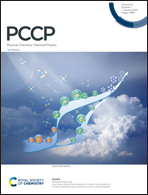A theoretical study on pseudo Mott phase transition of vanadium dioxide†
Abstract
The structural phase transition (SPT) and metal–insulator phase transition (MIT) always occur simultaneously upon heating from the low-temperature insulator M1 phase to the high-temperature metal R phase in vanadium dioxide, and it is still unclear which one of Mott correlation and Peierls distortion plays a decisive role in the thermally induced phase transition (PT) since 1959. Our density functional theory (DFT)-based calculations revealed that the intermediate phase in the PT, the so-called monoclinic metal phase, is a zero indirect band gap semimetal (P21/c space group) with a pseudo gap (199 meV). From the M1 phase to the monoclinic metal phase, the band gap decreases gradually to zero, and the bonding lengths between vanadium–vanadium atoms remain nearly constant. The SPT and MIT from the intermediate structure to the R phase occur simultaneously with a sudden change of bonding lengths between vanadium–vanadium atoms, in which electrons can jump down rather than jump up to the conduction band minimum (CBM) from the valence band maximum (VBM) under thermal fluctuation in order to lower the total energy of the system to push forward the occurrence of PT. The electron jumping does not require additional energy from Coulomb repulsion between electrons even though it is always present. This SPT is a typical Peierls PT or a pseudo Mott PT rather than an actual Mott PT in the each of the two stages. Our conclusions provide a new understanding of SPT and MIT in vanadium dioxide that has been debated for more than 80 years.



 Please wait while we load your content...
Please wait while we load your content...